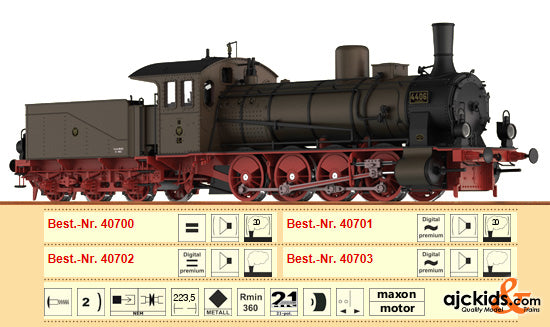Brawa 40700 - Steam Locomotive G 7.1 K.P.E.V.
Order no. 40700 - 40703
Model: Road no. Saarbrü, cken 4406
At the beginning of the 1890s, 3-fold coupled goods train locomotives had reached the limits of their performance, and it was necessary to pass over to 4 coupled wheel sets. The operation particularly called for a locomotive in order to do without additional harnessing and pushing services on intense and long slopes. Speed was secondary, and a wheel diameter of 1,250 mm was thought to be sufficient. The design drawings were prepared by Vulcan in Stettin, and the first 4 machines were delivered in 1893. The locomotives proved their worth, and they were included under the master drawing designation III 3 d in the standards for uniform design and construction (&bdquo, Normalien&ldquo, ) for operating equipment. Until 1910, more than 1,000 G 71 locomotives were delivered to the directorates of the Royal Prussian Railway Administration (K.P.E.V.). The KED Essen bought the majority with 347 units, KED Cö, ln came in second with 197 machines, and Breslau bought 84 locomotives. As this shows, the main application of heavy goods traffic was in the industrial belt on the Rhine and the Ruhr, as well as in Silesia. In addition to the K.P.E.V., LBE (3) and Gutehoffnungshü, tte (7) had also purchased tractive units in the Deutsches Reich according to the pattern of the K.P.E.V. From 1916 to 1918, the K.P.E.V. had about 200 more machines built. The most striking changes were the 2 sandboxes that were now available, and the larger tender 3T16,5. These locomotives were available to the royal military railway after their delivery, and came into use in the First World War. Once the war ended, there were large gaps in the G71 stocks. Many locomotives were lost in the chaos of war, remaining in foreign territories. A large number had to be given to the victors as part of the ceasefire and reparations. So, among others, Poland received 142 locomotives and 103 units were delivered to France. As a result, the Prussian G71 came into use throughout half of Europe after 1918. 680 locomotives had been recorded in the preliminary standardised renumbering plan (&bdquo, Umzeichnungsplan&ldquo, ) of the Deutsche Reichsbahn Gesellschaft (DRG), and 660 were renumbered as 55 001 - 55 660.
Model:
- Boiler, locomotive chassis and tender box in die-cast zinc
- Finest metal spoked wheels
- True-to-epoch lighting, multipart lamp housing
- Illuminated driver&rsquo, s cab
- Spring buffers
- Detailed boiler rear wall
- Short coupling between locomotive and tender
- Perfectly replicated back boilerplate
- Filigree rods and coupling rods
- Precise printing
- Pipes and extra mounted parts in low material thickness
- Digital version with glowing of the ash container
- Movable valve gear inside the frame
- Closed front end, exchangeable part and coupler pocket enclosed
EAN/UPC: 4012278407005



